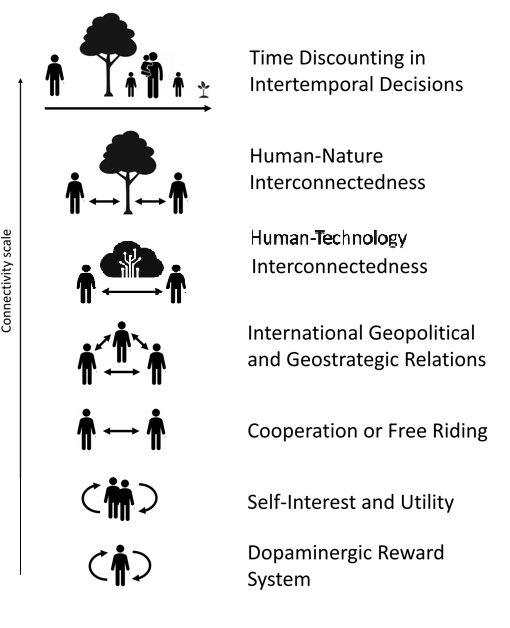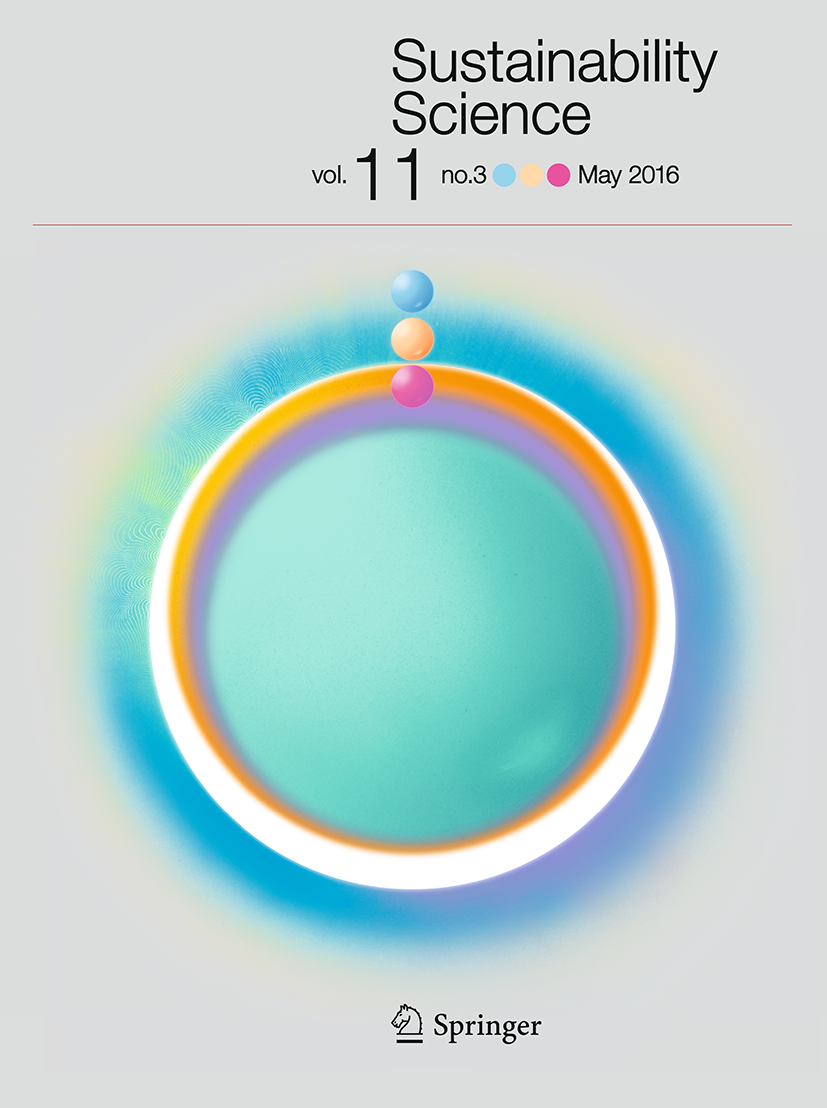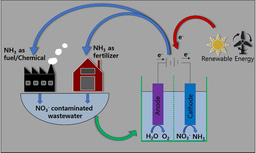Softening Sustainability Boundaries: From Insight to Transformation
Published in Earth & Environment, Sustainability, and Law, Politics & International Studies

By Jiesper Tristan Pedersen; Santos, Filipe Duarte; O’Riordan, Tim; and de Sousa, Miguel Rocha.
Based on two publications in Sustainability Science (Santos et al., 2025, 2024)
1. Unveiling the human dimension
Our journey began by confronting a significant puzzle: despite widespread awareness, global progress towards sustainability remains limited. In our first paper, “Unveiling global sustainability boundaries: exploring inner dimensions of human critical determinants for sustainability” (Santos et al., 2024), we introduced a methodology to identify six Human Critical Determinants (HCDs) that have emerged through human biological and cultural evolution. While essential for human survival, well-being, and prosperity, these determinants paradoxically act as Human Sustainability Boundaries (HSBs), constraining our collective capacity to achieve sustainability. Identifying those sustainability boundaries contributes to the overarching goal of “Knowing ourselves” (Plato and Jowett, 1990). Knowing these boundaries and how they act, avenues for surmounting them can be explored, thus facilitating the path towards sustainability.
The boundaries include critical dimensions such as the dopamine-driven reward system, intertemporal decision-making (individual), collective value systems and behavior, self-interest regulation, unconditional cooperation, and international collaboration. Each boundary represents internal psychological and behavioral constraints, making sustainable action challenging. For example, the dopamine system encourages short-term gratification rather than long-term sustainability goals, while limited intertemporal decision-making inhibits proactive, long-term environmental planning.
We argued that softening these boundaries (transforming personal behaviors, beliefs, and collective actions) can catalyze deeper societal and institutional changes necessary for global sustainability.
2. From identification to implementation
Our second paper, “The urgency of the Lancet Planetary Health–Earth Commission’s report and IPBES transformations versus the ongoing Z transformation: the need to soften the human sustainability boundaries” (Santos et al., 2025), expanded upon this framework by adding a seventh determinant, “human–technology interconnectedness (HTI)". HTI captures humanity’s increasing entanglement with technology, including its effects on autonomy, critical thinking, and social cohesion. It connects to the somatic and psychological well-being required for sustained engagement with sustainability. We critically examined the Lancet Planetary Health–Earth Commission’s ambitious call for translating Earth-system boundaries into transformative action, highlighting how individual willingness and societal engagement depend fundamentally on addressing and softening the HSBs.
In this paper, we critically assess the transformative ambition of the Earth Commission and IPBES, arguing that the success of global mitigation and adaptation depends not only on system-level targets but on addressing the deep-seated behavioral and psychological barriers embedded in the HSBs. By softening these boundaries—through psycho-social awareness, cultural transformation, and systemic support—we can increase the feasibility of realizing sustainability.
The paper communicates a substantial barrier: the entrenched “Z transformation,” rooted in the Neolithic and Industrial Revolutions, characterized by self-interest, competition, utility maximization, and nationalism. This prevailing transformation actively hinders the softening of human boundaries and obstructs the necessary shift towards sustainability. Fig. 2 illustrates the 7 SBs organized by connectivity, from individual to collective.

Fig. 1. Representation of the seven Human Sustainability Boundaries (HSBs) organized along a connectivity scale, from individual-level psychological constraints (e.g., Dopaminergic Reward System) to global interconnections (e.g., International Geopolitical Relations).
Each boundary highlights internal factors limiting sustainable behaviors and decisions, with arrows illustrating interdependencies and interactions. Source: originally developed by David Avelar based on the 6SBs (Santos et al., 2024), and adapted by authors; technological interconnectedness (HTI) AI-generated symbol.
3. Softening boundaries for sustainable transformation
Softening these human sustainability boundaries involves nurturing psychological flexibility, cultivating intertemporal awareness, promoting collective and empathetic practices and behaviors, and shifting societal values from individualistic competition to cooperative and interdependent models. By facilitating inner personal transformations, such as encouraging emotional intelligence, critical self-reflection, and deeper human-nature connections, we enable broader, resonant shifts within institutions and governance structures.
Our work outlines practical research pathways:
- Enhancing self-care and self-control (moderating immediate rewards) to align personal practice with sustainability
- Encouraging long-term decision-making that prioritizes future collective well-being
- Shifting collective behavior and value systems to acknowledge human-nature interdependence
- Restraining individual self-interest and promoting cooperative economic practices
- Cultivating cooperation to provide public goods and ensure equity and justice
- Promoting international collaboration towards common global sustainability goals
- Promoting pre-tested technologies, education in and safe use of techs
3.1. Brief introduction and ways of softening the seven SDs
-
Dopaminergic Reward System (DRS)
This boundary addresses our neurological predisposition toward immediate rewards and short-term gratification, driven by dopamine. By enhancing our ability to moderate immediate impulses through conscious practices, we can align short-term motivations with long-term sustainability goals, supporting responsible and mindful consumption patterns.
Improved vitality may soften this boundary, prioritizing holistic health and wellbeing. Vitality encompasses physical, psychological, and existential well-being necessary for sustained individual and collective engagement in sustainability. By prioritizing trauma therapy (Miller, 1981), holistic health, and wellness, we strengthen personal resilience, enabling deeper, more sustained commitments to personal sustainability transformations.
-
Time Discounting in Intertemporal Decisions (TD)
TD refers to the human tendency to value immediate rewards over future benefits, undermining long-term sustainability efforts. Softening this boundary involves cultivating greater appreciation for the future through education and policies promoting long-term thinking and intergenerational equity.
Considering and caring about the future may be awakened by cultural and group values on a national level. Cultural institutions like education systems and media can support cultivating this long-term mindset (Anderson, 2020). Democratic systems with short-term elections (and political perspectives) oppose long-term (scientific) thinking.
-
Human–Nature Interconnectedness (HNI)
The erosion of direct dependence on nature has diminished our ecological awareness. Reviving HNI through education, immersive experiences, and policy changes helps individuals recognize their reliance on natural ecosystems, encouraging responsible environmental stewardship and sustainable living.
Increasing urbanization may disconnect humans from Nature, e.g., deficiency from hunting or growing your own food. Reconnecting through direct interactions, such as local food production, may strengthen human-nature ties.
-
Self-interest and Utility (SIU)
Deep-rooted self-interest and utility maximization drive consumerism and economic practices detrimental to sustainability. Transforming this boundary involves promoting collective interests and equitable economic practices, cultivating a balance between individual satisfaction and broader societal and environmental well-being.
Softening this boundary involves developing policies that incentivize collective well-being and equitable distribution of resources. Promoting ethical practices (Shove et al., 2012) and norms, empathy-driven education, and redefining social success to emphasize communal benefits and environmental stewardship can transform self-interest into cooperative social practices.
-
Cooperation and Free Riding (CFR)
Effective sustainability actions require cooperation, but tendencies toward free riding impede collective efforts. By cultivating empathy, compassion, and knowledge-sharing, we can enhance voluntary cooperation, ensuring widespread and committed participation in sustainability initiatives.
To soften this boundary, cultivating communities of trust, enhancing transparency, and emphasizing collective narratives through education can reduce free riding behavior. Encouraging altruism and promoting collaborative frameworks through social incentives and communal recognition enhances voluntary cooperation. Governments may support NGOs that cultivate volunteer engagement that benefit society or vulnerable segments, e.g., food saving programs.
-
International Geopolitical and Geostrategic Relations (IGGR)
Geopolitical tensions and competitive interests between nations hinder collective global sustainability actions. Encouraging international dialogue, trust-building, and cooperation on shared global challenges can soften this boundary, creating unified efforts to address environmental crises.
Softening IGGR requires proactive diplomacy, international treaties that emphasize shared environmental and societal goals, and cultivating global empathy through cross-cultural exchanges. Strengthening international institutions to mediate conflicts and coordinate unified sustainability policies promotes cooperation over competition.
-
Human–Technology Interconnectedness (HTI)
HTI reflects humanity's profound dependence on technological advancement. While technology greatly improves health, longevity, and economic prosperity, it also poses risks like weaponization, cyber warfare, disinformation, and loss of critical thinking. Addressing and mitigating these technological risks and promoting responsible, sustainable technological use is essential for softening this boundary.
To soften this boundary, national, regional or international policies must emphasize ethical technology use, responsible and sustainable regulation of technological threats (Beck, 1998), and robust digital literacy education. Promoting innovations that prioritize sustainability, transparency, and global well-being over competitive advantage and personal utility ensures technology becomes an enabler rather than a barrier to sustainability.
4. Moving Forward
These papers emphasize that achieving sustainability is more than a scientific or technological challenge. It is fundamentally cultural and psychological. Recognizing and softening human sustainability boundaries opens avenues for transformative action and genuine progress towards a sustainable future. Our continuing research aims to bridge the gap between inner personal & cultural transformation and large-scale global impact, essential for sustainable development in the Anthropocene.
References
Anderson, B., 2020. Imagined communities: Reflections on the origin and spread of nationalism, in: The New Social Theory Reader. Routledge, pp. 282–288.
Beck, U., 1998. Politics of Risk Society, in: Franklin, J. (Ed.), The Politics of Risk Society. Polity Press/IPPR, Cambridge, pp. 9–22.
Plato, Jowett, B., 1990. The Dialogues of Plato: Translated Into English with Analyses and Introductions. Bigelow, Smith.
Santos, F.D., O’Riordan, T., de Sousa, M.R., Pedersen, J.T.S., 2025. The urgency of the Lancet Planetary Health–Earth Commission’s report and IPBES transformations versus the ongoing Z transformation: the need to soften the human sustainability boundaries. Sustain Sci. https://doi.org/10.1007/s11625-025-01708-5
Santos, F.D., O’riordan, T., Rocha De Sousa, M., Pedersen, J.S.T., 2024. Unveiling global sustainability boundaries: exploring inner dimensions of human critical determinants for sustainability. Sustain Sci 1–6. https://doi.org/10.1007/S11625-024-01462-0
Shove, E., Pantzar, M., Watson, M., 2012. The Dynamics of Social Practice. Everyday life and how it changes. SAGE Publications Ltd., London.
Follow the Topic
-
Sustainability Science

This journal offers insights into interactions within and between nature and the rest of human society, and the complex mechanisms that sustain both.





Please sign in or register for FREE
If you are a registered user on Research Communities by Springer Nature, please sign in